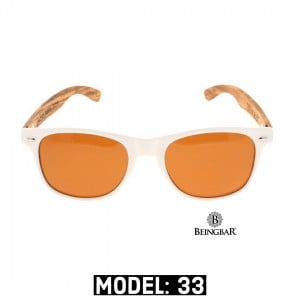You already know that there are many different types of sunglasses. From different brands, to different models to different shapes. The variation is almost endless. But what you perhaps do not know, is that there is a significant difference in the lenses used in shades. Your lenses are arguibly the most important aspect of the sunglasses because they determine their functionality. And how well they do their job.
Four types of lenses in common use
In this article we explore the differences in lenses for sunglasses. We distinguish four types that are in most common use. So, does this mean that these four types are all the different lenses that exist? No, certainly not!
This is the eyewear and optical industry. And most most brands and companies make most of their money on the upsell of "premium" lenses and lens coatings. That means new lenses are invented regularly. And all of them have just a slightly different functionality. So in this article we only cover four common types: polarized lenses, photochromic lenses, Blue Light and anti-reflective lenses. Read all about it in this article and become an instant expert.
Different sunglasses lenses
What is the most important aspect of your sunglasses? Some might think that their style and looks are the most important. But if you're interested in shades for their funtionality, there is something else you should look at first.
Sunglasses, in principle, should always protect your eyes against UV rays. UV rays can damage your eyes on sunny and even on cloudy days. And the lenses in your sunglasses shield your eyes from these harmful rays. They protect your eyes from damage. So whenever you look for new shades this season, don't just flaunt your personality and show off how fashionable you are. Here are four different types of sunglasses lenses for you to select from.
Polarized lenses:
Polarized lenses reduce glare caused by intense light reflecting from a often horizontal surface. Typically surfaces like water, snow and the road. These lenses make your vision significantly clearer and sharper in these circumstances. Polarized lenses are available for both prescription and non-prescription sunglasses.
People who are what we call light-sensitive are often advised to wear them indoors. This includes people who underwent eye surgery. And also people who have been consistently exposed to too much sun in their lives, for instance because of their outside career.

Do polarized lenses block UV rays?
Quality polarized sunglasses do protect your eyes from UV rays. However, this is not because of their polarizing capabilities, but because of the standard UV blocking built in. If you choose sunglasses with a "UV 400" indication they block both harmhul UV-A and UV-B rays. About 99-100% of UVA and UVB light, with wavelengths up to 400 nm, to be precise. This is crucial to maintain healthy eyes and good eyesight.
Photochromic lenses:
Photochromic lenses are special. They are also called "transition lenses", "light adaptive lenses" or "light intelligent lenses". They adjust to the environment you use them in. They become darker in bright (sun)light conditions and also protect your eyes from UV rays (just like UV 400 lenses do). Photochromic lenses exist in both glass (mineral) and plastic lenses. Just note that the plastic lenses lose their photochromatic abilities after 2 to 3 years of use.
Blue Light blocking Lenses:
Blue Light lenses are regarded as a next-generation lenses. its coating is designed to prevent digital eye strain. What we mean by digital eye strain is the eye fatigue caused by blue light emitted from digital screens (TV, laptops, phones, tables)
In recent years there has been quite some research done to understand the true benefits of Blue Light blocking lenses. Famous research results from the American Academy of Ophthalmology indicates that these lenses typically only filter out 20 to 30% of the Blue Light. And although these lenses are marketed for indoor, digital use, most Blue Light is emitted by the sun. Another interesting fact is that quality sunglasses will filter out more Blue Light than Blue Light blocking lenses.
Anti-reflective lenses (coating):
Anti-reflective lens sunglasses do what standard sunglasses do when it comes to blocking UV-A and UV-B rays. But these lenses can minimize eye strain and eye fatigue caused by bright light, glare and reflections of the light, including halos that you can sometimes see around a light source. These lenses make your vision clearer. Some types of coatings protect your lenses from scratches, water and dust.
When you select your sunglasses you should always consider what kind of lens you need for your lifestyle and environment. You need a combination of safety and comfort. Blend that with the style you're looking for and you have your ultimate pair of sunglasses.
So, this concludes this article about the main different types of sunglasses lenses. As I mentioned there are more types of lenses that we did not cover in this article. However, we'll cover these in another, future article. These other types of lenses are:
- Multifocal lenses
- Mirror-coated lenses
- Mirror lenses (or coating)
- Gradient lenses
- Double gradient lenses
Are you interested in reading more about high quality sunglasses? Sunglasses that have all premium features built in without the premium pricing you see so often? With polarized lenses as a standard in every model? BEINGBAR shades are the ultimate conscious and sustainable sunglasses, made with natural materials. For people who make their own conscious choices. Click here to read more. Or visit BEINGBAR.com



